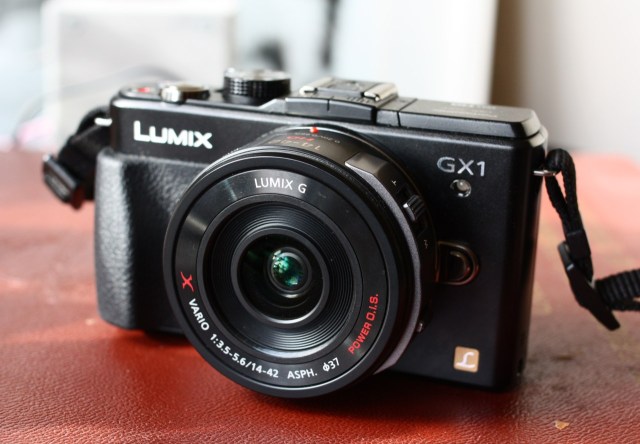
Short version:
A return to form for Panasonic, and a M4/3 camera that photographers won’t be suspicious of. Its weaknesses are largely the weaknesses of its class of camera, but beyond those it’s solid, comfortable, and fairly powerful. Not recommended for fidgety and manual focusers, but most shooters will be able to have a lot of fun with it.Features:
- 16-megapixel micro four-thirds sensor
- 3″ 480×320 touchscreen
- Debuts with new 14-42mm 3.5-5.6 lens (power zoom or traditional)
- Stereo mic for HD video
- MSRP: $700 (body only) $950 (as reviewed, with 14-42mm power zoom)
- Compact and easy to handle
- Most settings quickly accessible, some customizable
- Quick autofocus, good image quality up until ISO 6400
- Manual focus not much fun
- Touchscreen seems slightly vestigial
- Thumb dial could be a lot meatier
Full review:
The GX1 represents Panasonic listening to its fans, who have been slightly dismayed at the continual consumerification of the M4/3 line. The original G-series set them out to be the serious, enthusiast’s M4/3 camera maker, but as the sensor and market advanced, we saw them focusing more on simplification and popularization. That trend is bucked with the GX1, the announcement of which many greeted with relief.It’s clear from even a cursory examination that the GX1 is meant to be a “serious” camera. Its boxy but carefully designed shape, the thumb dial, the constellation of buttons. Although it will, in fact, take a picture when you press the shutter release button, it’s not the kind of camera you just hand to mom and say “take a few shots would you?”.
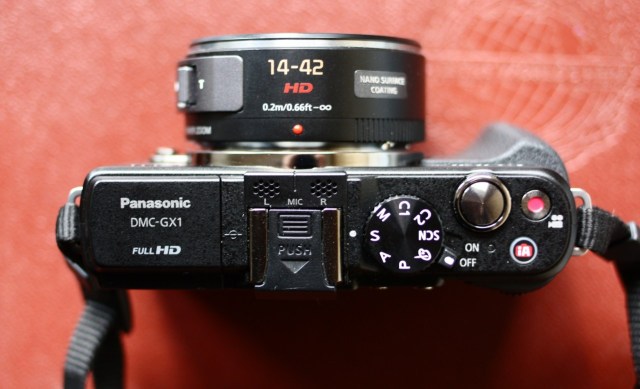
The design of the camera is straightforward and not very aggressive. The only real topography is found on the right side, where a fairly subtle bump on the front, highly textured, allows you to grip tightly. On the back, a thumbgrip that feels bigger than it looks (that’s a good thing) makes for easier one-handed operation, though you won’t be changing any settings while doing that.
There’s a fun little popup flash that’s elevated enough that you won’t catch the shadow of your lens in the picture. It’s not particularly powerful, but it’s there, and it’s fun to pop in and out.

I’d say my only real concern with the camera physically speaking is the thumb dial. It’s recessed just enough that rotating it is an effort. And getting to the secondary settings by pushing it in? Forget about it. I couldn’t do it reliably, and I wouldn’t want to have to rely on the push-and-turn mechanism at all. This dial could definitely stand to be bigger and have better feedback.
Touchable-ish

Its rear LCD is a touchscreen, though you wouldn’t really guess it from the look of the menus. It seemed to me that the touch capability was more of an afterthought, and while it can be handy (the little drawer of settings you can pull out from the right is nice), it’s not really useful for any kind of serious applications. For instance, you can see the image type being recorded (RAW+JPEG, for example) on the LCD, but touching it doesn’t bring up the menu for that setting. You have to go through the regular sub-menus, only some of which are touch-sensitive. And while you can, say, drag the histogram around or select a focus point, or drag through photos in playback mode, it still doesn’t really feel like it’s living up to its potential. Hopefully the GX2 will have a menu system designed around touch and d-pad from the ground up.
As for the menus and settings themselves, I found them easy and occasionally very convenient to use. In shutter priority mode, spinning the jog dial brought up a very helpful little dual ribbon showing aperture estimates for exposure length, and red zones for areas unlikely to produce a good shot. Similarly, the quick menu and d-pad buttons brought up useful settings quickly and I really felt like for the most part, I had access to almost every necessary setting within a second.
Shooting
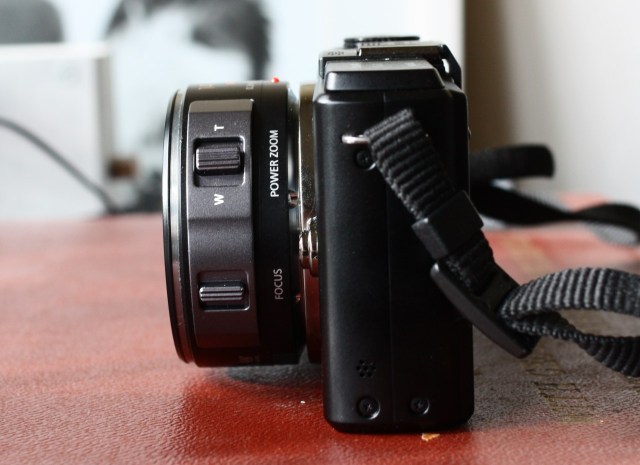
The lens that our unit had, and one many will opt for, is a new compact 14-42mm F/3.5-5.6 with both power zoom and power focus. It’s very compact when the camera is off, but a front element protrudes about an inch when it’s powered on. The on/off process is fairly quick, so it’s no trouble to turn it off when you need the camera to be more portable, though I personally would prefer a nice pancake prime to minimize size. As a kit lens this isn’t bad at all, and it’s more compact than many of the zooms offered on other M4/3 platforms.
Autofocus is very fast and accurate; I preferred to use the “pinpoint” mode, which both speeds up focusing by reducing the points needed to poll and adds accuracy. I’m a “focus, then frame” kind of guy, and this camera worked very well with my style of shooting. Unfortunately, manual focus was… well, listless.
The actual shooting action feels and sounds good. If you’ve got your focus set, the shutter fires instantly when you push down the button, and while you have to dismiss the image preview before shooting another shot, it’s ready to fire again quite quickly — less than a second for me. Serious shooters will want to disable the image preview, or set it to one second. Starting video is just as quick via a dedicated button, great for when you’re taking shots of the kids or pet and something darling happens – no need to change modes.
Photo quality, though it is of course highly important, I don’t want to delve too deeply into. I’ll leave that to great sites like DPReview, where they can take the systematic approach warranted by a major camera like this one. But to speak anecdotally, I found that pictures were generally sharp, with very low noise up until ISO 6400. JPEGs are rendered a bit flat in the “standard” render style, and it’s definitely worthwhile to test out the other modes, which are fairly subtle. The art-style modes are a bit much, of course, and you can always do adjustments in post. Find a good JPEG style that agrees with your subject matter and do the effects later.
Here are a couple basic sample shots (be sure to open in new tab for full size). You can really see the flatness in the books and the pachinko machine. Most people would be unhappy with that, so it’s important to dig around in the settings on this thing.



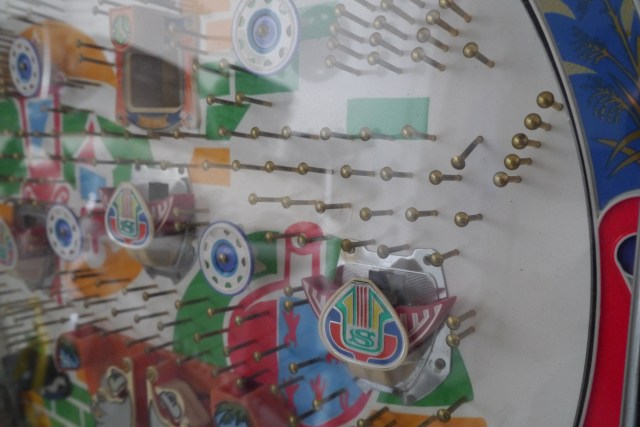
And here are three pictures in relatively low light, just bright enough for handheld shots. The first is 3200, then 6400, then 12800, at a 20th, 30th, and 60th respectively to keep the aperture at just about wide open.
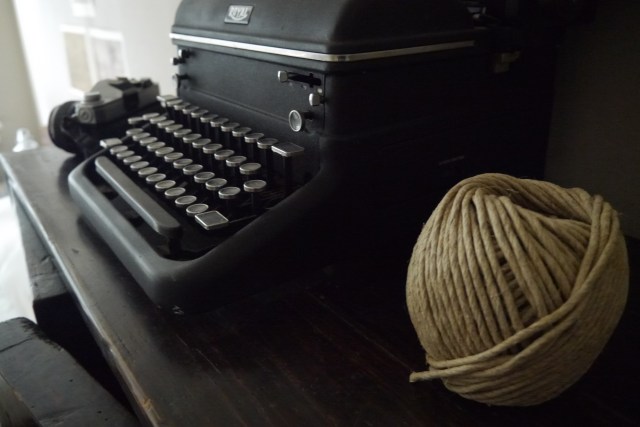


Not the sharpest shots, unfortunately. But they’re enough that you can really see the noise jump at 12800, and it’s certainly very present at 6400. Nevertheless, I wouldn’t feel any compunction shooting at 6400 if it was the only way to get the shot. 12800 is just too noisy, which can usually be said of any camera’s maximum ISO setting.
Video quality, from what I could tell, was comparable to other medium-size sensors, better than point and shoots of course but not as good as what you’d get on a Canon or Nikon APS-C. Perfectly all right for home videos, though I wouldn’t want to shoot a feature on it.
Conclusion
The GX1 is a powerful camera, but I sense that it still has one foot in the half-point-and-shoot territory of the GF3. This clearly wants to be a photographer’s camera; it’s not easy enough to use to be anything else. So why so many auto and art modes? Why a touchscreen and a galaxy of buttons? There’s just a hint of identity crisis here that its successor will hopefully address. But disregarding those issues, the GX1 is a powerful contender against the likes of Samsung, Sony, Olympus, and the rest, offering a sort of camera-lover’s camera without any gimmicks or weird styling. It’s practical, compact, and performs well. What more do you want?Source:http://techcrunch.com/2012/02/01/review-panasonic-lumix-gx1/

No comments:
Post a Comment